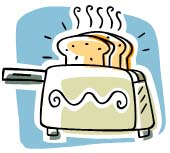
How much can you remember about personal pronouns?
Which ones do we use for the object in the sentence, and which do we use for the subject? When do we use them and why?
In the following sentences, can you replace the words in quotation marks ("") with the correct personal pronoun?
I've given you the list of personal pronouns to help you remember.
When you're finished, see if you can post the answers to the questions above.
Lesson by Caroline Devane
Homophones are words that sound the same, but have different spellings and meanings.
For example:
pear and pair
Pear - a sweet and juicy type of fruit.
Pair - a couple: two items of the same kind. A set of two similar things considered as a unit
Check your understanding of irregular past participle verbs.
Present Simple: do - "Where do you live?"
Past Simple: did - "Where did you go yesterday?"
Past Participle: done - "Has he done all his homework?"
Collocations are words that go together. For example:
"In this class everyone must do their homework".
Do and homework go together. In the following sentences can you decide what the correct collocation is? You have four choices:
Do
Make
Take
Have
This and that are for singular nouns.
This is used for an object which are near to use
That is used for an an object which is not near to us.
"This is my pen in my hand."
"That is my bag you are carrying."
I have £10 and I want to buy this car:

Unfortunately this car costs £100,000
I don’t have enough money. The car is very expensive and I will never be rich enough to buy it.

How many slices of toast can you see? Is toast countable or uncountable?

How many pieces of cake can you see? Is cake countable or uncountable?
Decide if these types of food and drink are countable or uncountable:
Lesson by Sam, EC London English languge school
It is all very well knowing the vocabulary for furniture around the house, but do you know the prepositions that go with them?
In each of the sentences below, I have removed the preposition. Can you remember which one you need to complete the sentence?
Lesson by Caroline
Adverbs of Manner add more information to verbs to make them more specific. For example “He ran” doesn’t say much about how he ran. If you add an adverb it will solve this problem: “He ran quickly” gives us more information and sounds better.
Adverbs of Manner always come after a verb and can be used with words like very or too. Adverbs of Manner are adjectives that almost always end with –ly, though some are also irregular.
Important tip: much is always used together with an uncountable noun (like 'oil' or 'water') while many is always used with nouns that are countable (like 'table' or 'computer')
It's also good to know that 'too' means that you don't like the situation, for example, "There is too much food on my plate" means that you're not happy about it.